Leafy!
I have now been living in Australia for a little bit over two years, and I am well on track in my quest to photograph the Aussie iconic wildlife! I had the pleasure of shooting kangaroos, wallabies, and koalas in the wild; I photographed my share of Aussie bird-life including some of those fantastic parrots, and I shot some sharks, some of the dangerous spiders crawling over the land down under, and the weedy seadragon.
The latest addition is the leafy seadragon, Phycodurus eques, an amazing seahorse-relative found on the Australian south coast. This fish truly represents an apex of vertebrate evolution. Evolutionary pressures have morphed the basic seahorse body-shape into a bouquet of flaps and tassels resembling the seaweed abundantly growing along the south coast of the Australian continent. For anyone but the most skilled observers, the leafy seadragon looks like a floating piece of detached seaweed. If not explicitly looking for it, a diver would likely swim past it and not even realize that he is hovering next to one of these fascinating fish. I have heard stories of dive guides excitedly pointing at a leafy, while the beginner divers in their group had no idea why they were making such a fuss about an ordinary piece of weed, only to learn what they had missed upon resurfacing.
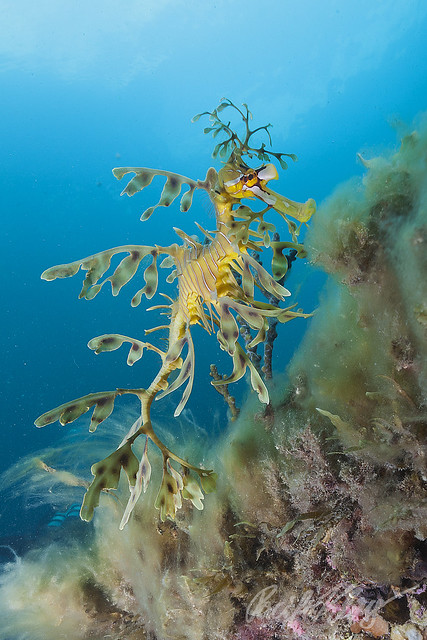
The body of this fish is a testament to the power of the fish and cephalopod visual systems which have evolved in the oceans of our planet. For the leafy seadragon, it’s a better deal to swim around with a bizarre array of skin flaps and not be seen by any predators, than to have a body useful for fast locomotion. So potent are the eyes and visual systems of the predators in the ocean, that having a bizarrely camouflaged body is more conductive to survival, in the case of the leafy, than to be able to outswim them. The leafy had to go to an incredible extreme in making his body akin to seaweed to fool the bigger, hungry ocean creatures.
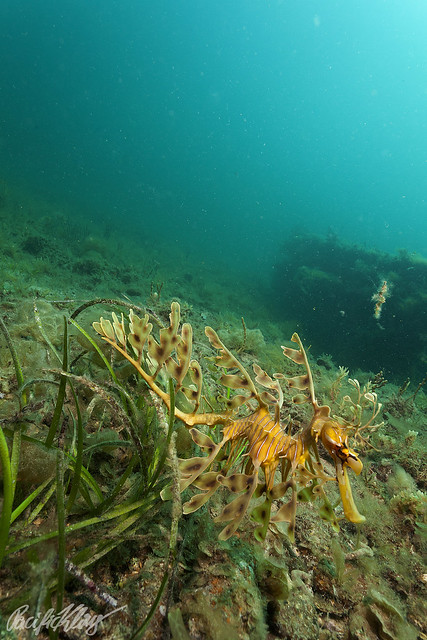
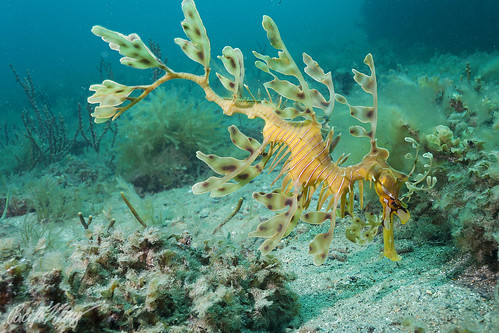
Seahorses & pipefishes evolved in the Eocene (~55 million years ago). A major evolutionary specialization of seahorses is a unique grasping tail for holding onto seagrass blades. This tail allows them to stay in place when facing at least moderate currents. With their close cousins, the pipefishes, they share a number of other interesting adaptations. One is a bony armor covering their bodies. Another adaptation is their suction-pipette like mouth, specialized for sucking up small crustaceans and fish fry. The fused jaw also served as the origin for the name of this group, the synganthidae (together-jaw fish). Seahorses and pipefish also share an unusual mating system, where the male protects the fertilized eggs by either sticking them to his body (pipefish and seadragons) or keeps them in a pouch (seahorses). Since the male leafy seadragons stick their eggs to their bodies, they are probably more closely related to the pipefishes than to the seahorses. A consequence of this task-sharing in reproduction is that in many species the male and female seahorses/pipefish swim together most of the time.

All of these adaptations were not particularly conductive to fast swimming. The bony plates make it hard for seahorses to twist their bodies from side to side, the way most fishes propel themselves forward. Hence, they swim by undulating their dorsal and anal fins, and while they can maneuver very precisely in this way, they certainly can’t swim very fast. Fast motion would also possibly rip off the eggs stuck to the males, and in any case, there is no need for speed when hunting tiny shrimp which can’t swim too rapidly themselves. Now, since most pipefishes and seahorses are small to medium-sized fish, they needed to come up with an evolutionary solution for not being able to escape. The bony plates in their bodies were one way of making life harder for predators, but expert camouflage is what worked very well for many of them. Even the average pipefish are often difficult to spot, as they look like dead twigs in the sand; the more colorful pipefish in the tropics sometimes hide in crevices. Seahorses don’t move much, and are really easy to miss when not looking for them. Some species in the tropics have evolved to closely resemble the soft corals they live on, such as the tiny Hippocampus bragibanti, a brilliant species prized by underwater photographers.
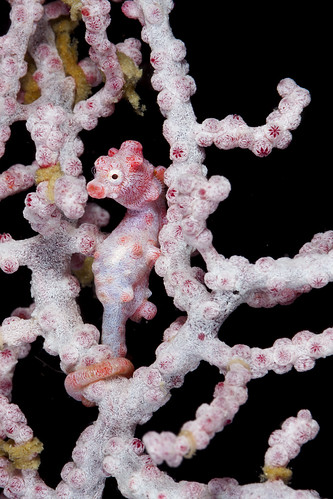
Another Australian seaweed-mimicking syngnathid is the weedy seadragon found in Sydney, Phyllopteryx taeniolatus, and south of it along the Australian coastline over to the warm-temperate parts of Western Australia. Just like the leafy seadragon, the weedy mimics marine vegetation, in its case the low-growing kelp found in the warm-temperate regions of Australia. I have found the weedy seadragon to be more shy than the leafy; the later simply ignored me when I encountered it at Rapid Bay, it was so convinced of its camouflage. The weedy, which I have observed several times in Kurnell south of Sydney, slowly but steadily tried to get away from me, hiding behind the kelp leafs. Typically, the edge between kelp growth and sand in 8 to 12 meters is where I can find weedies most reliably. The kelp does not only provide camouflage, but also a good environment for the weedy’s tiny prey shrimp to grow in.
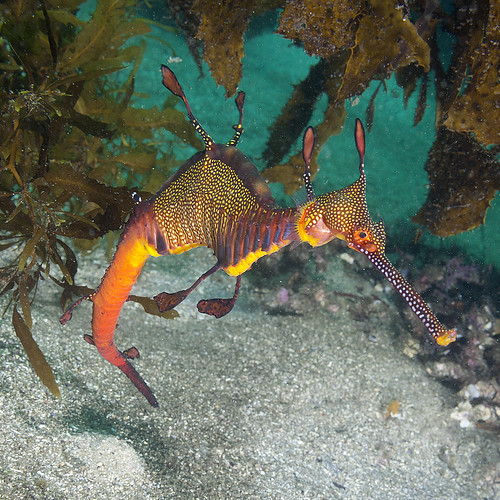
Both the weedy and the leafy seadragon are about 25-30 cm in maximal length, which is relatively large, compared to other seahorses and pipefish. It is tempting to speculate that the extreme level of camouflage in these two animals makes them safer from predation and had allowed them to grow a bit larger than their relatives.
It is not clear yet if the leafy and the weedy seadragon are decedent from a common weed-mimicking ancestor, or if they represent independent evolutionary solutions to making a pipefish look like a piece of marine flora.
The Sydney Harbor pygmy pipehorse, Idiotropiscis lumnitzeri, is another fascinating Australian syngnathid. Somewhere between a seahorse and a pipefish, it is among the smallest known vertebrates. It also mimics algae, but the filamentous algae often covering rocks in the Sydney region and not the large-leafed seaweed which the leafies mimic. This fish is extremely hard to find: I have spent several dives, armed with my camera setup in ultra-macro configuration, scanning Sydney dive sites where they are known occur, according to the word of reliable diving friends. I could not find a single individual yet. Hence my friend Big Al lent me this nice shot of a pipehorse:
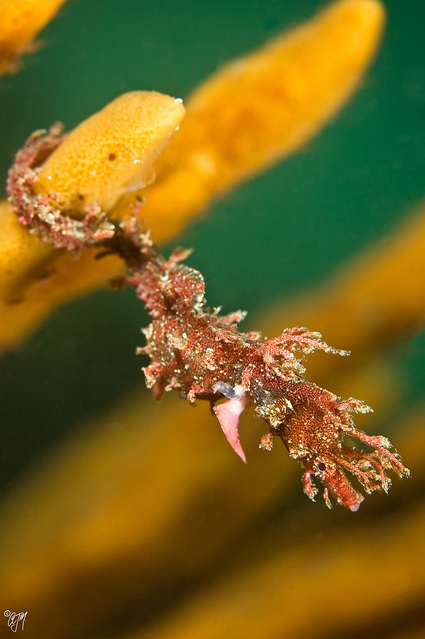
Generally, the seahorses and pipedragons have produced a number of very small species: The Sydney Harbor pygmy pipehorse, the aforementioned pygmy seahorse, Hippocampus bragibanti, and some tropical pipehorses like Acentronura gracilissima. I believe that their diet of very small crustaceans could have driven seahorse evolution towards these small sizes.
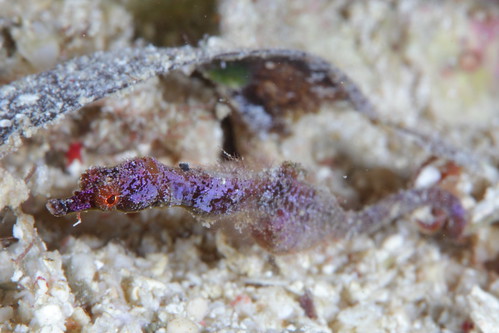
Many thanks to Leanne Emmins for her hospitality during my trip to South Australia!
I hope you have enjoyed both my (and Al’s!) photographs and my elaborations on all things seahorse. If you’d like to take pictures with me underwater and hear me talk about marine life, please consider joining me this September at the Evolution Photoganza in the Philippines.
And, I can recommend this very comprehensive book about seahorses, pipefishes and seadragons. I don’t actually own a copy, but have read through most of it during a stay in a dive resort. It features some really exotic and rarely seen animals.
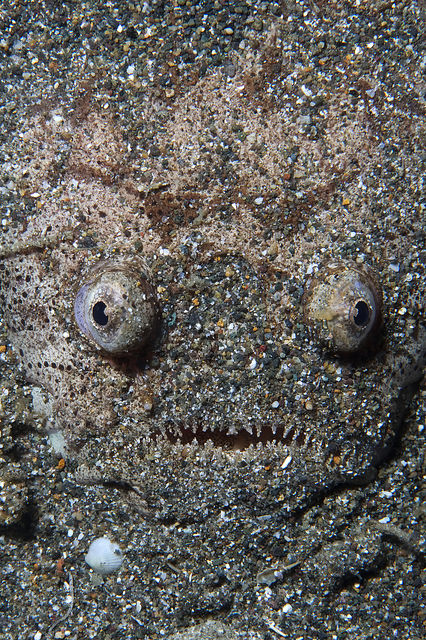
Absolutely incredible photos! Did you photoshop the fish to improve their proportions and complexion? 😉
P.S. I think maybe the book link at the end of the post is not working
Thanks! No, no photoshopping other than some brightness adjustment and minor removal of backscatter (illumination of suspended particles).
Hm, the book link works for me (using Firefox).
,Wonderful photos of our South Australian Marine Emblem, Leanne.